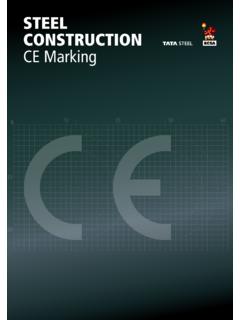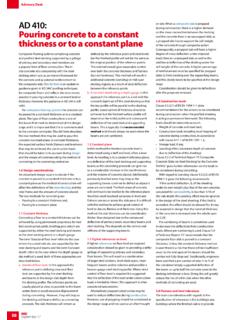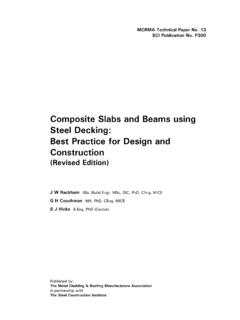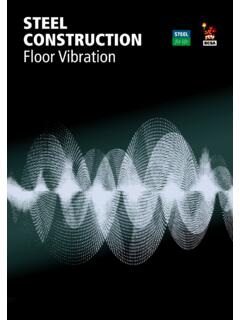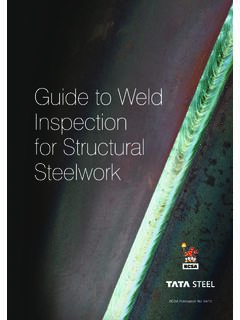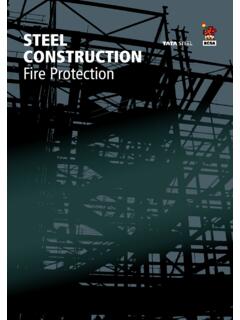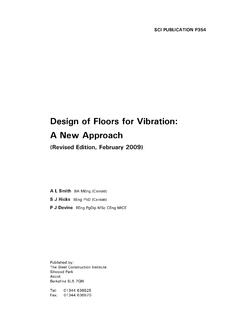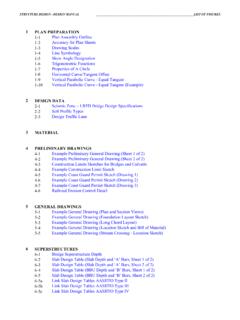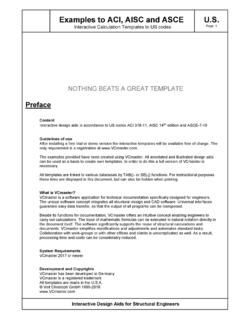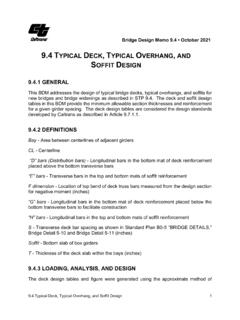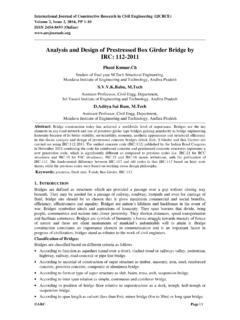Transcription of Composite Highway Bridge Design: Worked Examples
1 Composite Highway BridgeDesign: Worked Examples SCI (The Steel Construction Institute) is the leading, independent provider of technical expertise and disseminator of best practice to the steel construction sector. We work in partnership with clients, members and industry peers to help build businesses and provide competitive advantage through the commercial application of our knowledge. We are committed to offering and promoting sustainable and environmentally responsible solutions. Our service spans the following five areas: Membership Individual and corporate membership Technical information Courses Publications Online reference tools Education Codes and standards Construction solutions Sustainability Product development Research Engineering solutions Communications technology Websites Communities Design tools Assessment SCI assessed The Steel Construction Institute, Silwood Park, Ascot, Berkshire, SL5 7QN.
2 Telephone: +44 (0) 1344 636525 Fax: +44 (0) 1344 636570 Email: For information on publications, telephone direct: +44 (0) 1344 636513 or Email: For information on courses, telephone direct: +44 (0) 1344 636500 or Email: World Wide Web site: 24 X 7 technical information: SCI PUBLICATION P357 Composite Highway Bridge design: Worked Examples In accordance with Eurocodes and the UK National Annexes (including Corrigendum, March 2014) D C ILES MSc ACGI DIC CEng MICE Published by: The Steel Construction Institute Silwood Park Ascot Berkshire SL5 7QN Tel: 01344 636525 Fax: 01344 636570 ii Printed 11/03/14 2010, 2014 The Steel Construction Institute Apart from any fair dealing for the purposes of research or private study or criticism or review, as permitted under the Copyright Designs and Patents Act, 1988, this publication may not be reproduced, stored or transmitted, in any form or by anymeans, without the prior permission in writing of the publishers, or in the case of reprographic reproduction only in accordance with the terms of the licences issued by the UK Copyright Licensing Agency, or in accordance with the terms of licences issued by the appropriate Reproduction Rights Organisation outside the UK.
3 Enquiries concerning reproduction outside the terms stated here should be sent to the publishers, The Steel ConstructionInstitute, at the address given on the title page. Although care has been taken to ensure, to the best of our knowledge, that all data and information contained herein are accurate to the extent that they relate to either matters of fact or accepted practice or matters of opinion at the time ofpublication, The Steel Construction Institute, the authors and the reviewers assume no responsibility for any errors in or misinterpretations of such data and/or information or any loss or damage arising from or related to their use. Publications supplied to the Members of the Institute at a discount are not for resale by them. Publication Number: SCI P357 ISBN-13: 978-1-85942-195-6 British Library Cataloguing-in-Publication Data. A catalogue record for this book is available from the British Library.
4 P357-frontpages_Nov iii Printed 12/11/10 FOREWORD This publication is the second of two SCI Bridge design guides that reflect the rules in the Eurocodes. It gives two Worked Examples , one for a multi-girder Bridge and one for a ladder deck Bridge . It is a companion to a publication giving general guidance on Composite Highway Bridge design. The guidance in this publication has been developed from earlier well-established guidance in a number of SCI Bridge design guides. The previous guides referred to BS 5400 for the basis of design. The publication was prepared by David Iles, of The Steel Construction Institute. A technical review of the Examples , to confirm compliance with the Eurocode rules, was carried out by Atkins. Thanks are expressed to Chris Hendy, Rachel Jones and Jessica Sandberg, all of Atkins, for their comments. The work leading to this publication was funded by Tata Steel.
5 This publication includes references to Corus, which is a former name of Tata Steel in Europe iv Printed 17/03/10 v Printed 11/03/14 Contents Page No. FOREWORD iii SUMMARY vi INTRODUCTION 1 Worked EXAMPLE 1: Multi-girder two-span Bridge with integral abutments 3 Worked EXAMPLE 2: Ladder deck three-span Bridge 69 REFERENCES 129 CORRIGENDA (NOTED UP TO 10/3/2014) 130 vi Printed 17/03/10 SUMMARY This publication presents Worked Examples of the detailed design of two Composite Highway bridges.
6 Each Bridge is formed by steel girders acting compositely with a reinforced concrete deck slab. The first example is of multi-girder form, the second is of ladder-deck form. The Examples cover the principal steps in the verification of the designs in accordance with the Eurocodes, as implemented by the UK National Annexes. The publication is complementary to SCI publication P356, Composite Highway Bridge design, which describes both forms of construction and presents general guidance and an introduction to the relevant detailed requirements of the Eurocodes. 1 Printed 17/03/10 INTRODUCTION This publication presents two Worked Examples of the design of Composite Highway bridges using beam and slab construction. The evaluations of design values of actions (loads), action effects (bending moments, shears, etc.) resistances (of cross sections and of members in buckling) and limiting SLS criteria are carried out in accordance with the Eurocodes, as implemented by the UK National Annexes.
7 Reference is made to selected documents providing non-contradictory complementary information. References are made in the right-hand margins of the sheets to relevant clauses of the Eurocode Part, National Annex or other document. For brevity, the Eurocodes are designated as, for example, 3-1-5 , meaning BS EN 1993-1-5 and its National Annex. National Annex clause numbers are all prefixed NA . The two Examples are: 1. A two-span integral Bridge , each span 28 m, carrying a two-lane roadway. The reinforced concrete deck acts compositely with four main girders of constant depth. The example shows the calculation of action effects (from the results of a computer global analysis) and the verification of the main girders in bending and shear. The adequacy of a bolted splice in the main girders is verified. Fatigue assessment is carried out for certain key details. 2. A three-span ladder deck Bridge , spans m, 42 m , 24 5 m, also carrying a two-lane roadway.
8 The reinforced concrete deck acts compositely with a ladder-deck configuration of two main girders , at m centres, and cross girders at m centres. The main girders are of variable depth. The example shows the calculation of action effects (from the results of a computer global analysis) and the verification of the main girders and cross girders in bending and shear. The adequacy of the bolted connection between main girders and cross girders is verified. Fatigue assessment is carried out for certain key details. The detailed design of the deck slab, for local loading, is not covered in either example. 2 Printed 17/03/10 3 Worked EXAMPLE 1: Multi-girder two-span Bridge with integral abutments Index Section Page No. 1 Structural arrangement 5 2 Design basis 6 3 Actions on the Bridge 11 4 Girder make-up and slab reinforcement 16 5 Beam cross sections 17 6 Global analysis 22 7 Design values of the effects of combined actions 27 8 Verification of bare steel girder during construction 32 9 Verification of Composite girder 36 10 Longitudinal shear 44 11 Fatigue assessment 48 12 Main girder splices 54 13 Transverse web stiffeners 62 14 Bracing 67 4 Job No.
9 BCR113 Sheet 1 of 64 Rev A Job Title Composite Highway bridges: Worked Examples Subject Example 1: Multi-girder two-span Bridge Section 1: Structural arrangement Made by DCI Date July 2009 Silwood Park, Ascot, Berks SL5 7QN Telephone: (01344) 636525 Fax: (01344) 636570 CALCULATION SHEET Client SCI Checked by JMS Date Sep 2009 5 Printed 17/03/2010 1 Structural arrangement The Bridge carries a 2-lane single carriageway rural road over another road. The carriageway has m wide marginal strips, in accordance with TD 27/05 and has a 2 m wide footway on either side (this width is slightly less than the width for footways given by TA 90/05). A four-girder arrangement has been chosen, and a deck slab thickness of 250 mm has been assumed. The deck cantilevers m outside the centrelines of the outer girders ; a 250 mm thick slab is likely to be adequate for this length, carrying footway loading or accidental traffic loading. TD 27/05[ 1] TA 90/05[ 2] 280002800050050010001000370037003700marg inalstripmarginalstrip200020007300 1100 Job No.
10 BCR113 Sheet 2 of 64 Rev A Job Title Composite Highway bridges: Worked Examples Subject Example 1: Multi-girder two-span Bridge Section 2: Design basis Made by DCI Date July 2009 Silwood Park, Ascot, Berks SL5 7QN Telephone: (01344) 636525 Fax: (01344) 636570 CALCULATION SHEET Client SCI Checked by JMS Date Sep 2009 6 Printed 17/03/2010 2 Design basis The Bridge is to be designed in accordance with the Eurocodes, as modified by the UK National Annexes. The basis of design set out in EN 1990 is verification by the partial factor method. In this example the ultimate limit state STR/GEO is verified for persistent/transient design situations, using the combination of actions given by ( ): 1,k,0,Q1,k1,QP,k,GiiiijjQQPGE EN 1990 ( ) The fatigue limit state is verified for the reference stress range due to the application of the simplified fatigue load model (see below). Section Stresses in the structural steel, concrete and reinforcement are verified at the serviceability limit state for the characteristic combination of actions given by ( ) 1,k,01,k,kiiijQQPGE EN 1990 ( ) Crack widths in the deck slab are verified at the serviceability limit state for the quasi-permanent combination of actions given by ( ) 1,k1,2,kiijQPGE EN 1990 ( ) Partial factors on actions For persistent design situations, partial factors on actions at ULS are given by the NA: Permanent actions Unfavourable actions Concrete self weight G Steel self weight G Super-imposed dead G Road surfacing G Each of these actions is represented by a single characteristic value; factors for favourable actions would only be needed if the total effect of the action were favourable.
